“Global Healthcare Cloud Computing Market to reach a market value of 142.7 Billion by 2031 growing at a CAGR of 17%”
The Global Healthcare Cloud Computing Market size is expected to reach $142.7 billion by 2031, rising at a market growth of 17.0% CAGR during the forecast period.
Governments across the region are actively promoting digital health initiatives to modernize their healthcare systems and improve accessibility and quality of care. According to the National Library of Medicine, over 90% of hospitals in China had adopted EHRs by 2023. This widespread adoption generates massive amounts of health data, necessitating scalable and secure cloud computing infrastructure to manage and store this information. Hence, the Asia Pacific segment acquired 26% revenue share in the market in 2023. The adoption of cloud technology in this region has been driven by the increasing demand for digital health solutions, the rapid expansion of the economy, and the increasing investments in healthcare infrastructure. The rise of telemedicine, wearable health devices, and remote monitoring solutions in the region bolsters demand for cloud services.
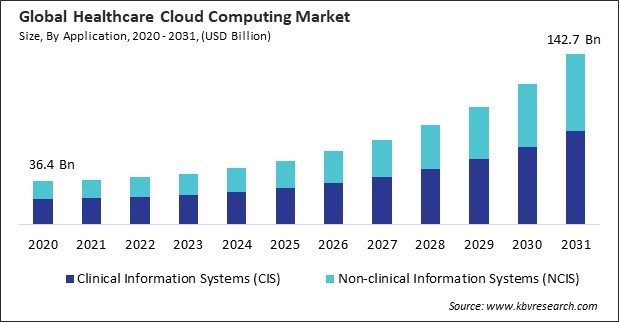
The major strategies followed by the market participants are Partnerships as the key developmental strategy to keep pace with the changing demands of end users. For instance, In February, 2024, Dell Technologies Inc. in collaboration with Ernst & Young Global Limited introduced the EY Edge Technologies Lab to enable businesses to harness the power of edge computing and AI for real-time data solutions. The Lab is designed to develop industry-specific use cases, enhancing speed, performance, security, and data management across various sectors. Additionally, In July, 2024, Amazon Web Services, Inc. came into partnership with GE HealthCare to develop AI models and applications for healthcare, aiming to enhance patient care through AWS's machine learning and generative AI technologies for improved data access, analysis, and personalized solutions.
Based on the Analysis presented in the KBV Cardinal matrix; Microsoft Corporation is the forerunners in the Healthcare Cloud Computing Market. In May, 2024, Microsoft Corporation came into partnership with Topcon Healthcare to enhance healthcare through AI-powered solutions using the Harmony platform and Nuance Precision Imaging Network. Companies such as Dell Technologies, Inc., Oracle Corporation and Koninklijke Philips N.V. are some of the key innovators in the Healthcare Cloud Computing Market.
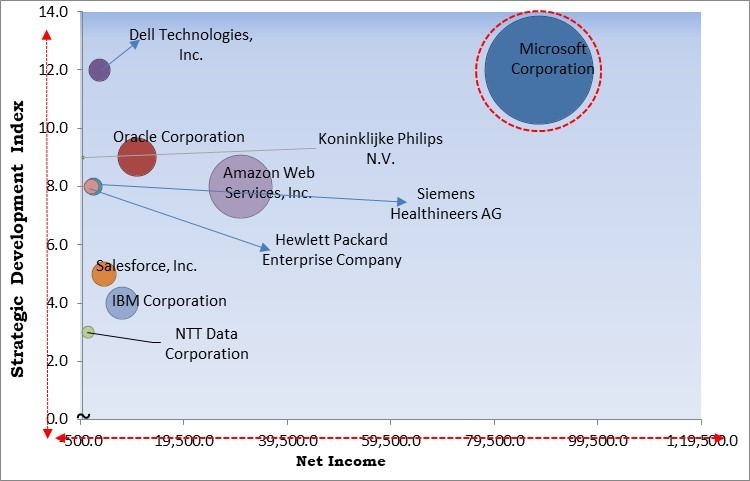
Initially, healthcare systems were overwhelmed by the sudden surge in patient volumes and the need for rapid response, leading to significant disruptions in IT operations. Many healthcare organizations, especially smaller clinics and hospitals, were unprepared for the transition to remote work and virtual care, causing delays in cloud adoption. Moreover, the crisis underscored the importance of data sharing and collaboration across healthcare systems, and cloud computing played a crucial role in enabling this. Thus, the pandemic had an overall positive impact on the market.
Telehealth, which provides healthcare services remotely via digital platforms, grew dramatically during the COVID-19 pandemic. Patients and healthcare practitioners were pushed to use telemedicine as a secure and successful alternative because of the necessity of minimizing the number of in-person visits that take place in healthcare facilities and the deployment of social distancing techniques. This shift has continued post-pandemic as telehealth has improved access to care, especially in remote and underserved areas. Hence, as telemedicine and remote monitoring gain traction, the demand for robust cloud computing platforms capable of handling vast amounts of data will only continue to grow, further fueling the expansion of the healthcare cloud computing market.
As the number of IoT devices in healthcare grows, cloud computing becomes essential for managing the vast amounts of data they generate. The International Telecommunication Union (ITU) notes that the convergence of IoT and cloud computing is critical to successfully implementing e-health solutions. Cloud platforms enable healthcare providers to scale their data storage and processing capabilities without substantial investments in physical infrastructure. Thus, the continuous evolution and adoption of IoT in healthcare, supported by government initiatives and international organizations, are expected to further drive the growth of cloud computing in the healthcare sector.
While cloud computing can ultimately reduce operational expenses through scalability, flexibility, and reduced hardware costs, the upfront financial outlay is often prohibitive, particularly for smaller clinics and hospitals with limited budgets. Achieving interoperability often requires custom development work, which furthers the initial investment. These interoperability challenges are technical and operational, as healthcare providers must ensure patient data flows smoothly between cloud platforms and on-premise systems without disrupting care delivery. Thus, the high cost of this technology may impede their widespread adoption.
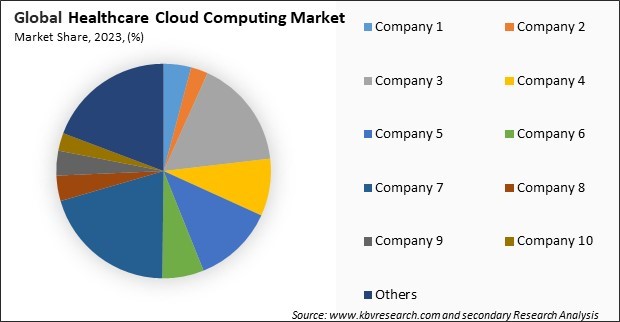
The leading players in the market are competing with diverse innovative offerings to remain competitive in the market. The above illustration shows the percentage of revenue shared by some of the leading companies in the market. The leading players of the market are adopting various strategies in order to cater demand coming from the different industries. The key developmental strategies in the market are Partnerships & Collaborations.
By application, the market is bifurcated into clinical information system (CIS) and non-clinical information system (NCIS). The non-clinical information system (NCIS) segment garnered 42% revenue share in the market in 2023. NCIS solutions focus on administrative and operational aspects of healthcare, including financial management, supply chain management, billing, patient scheduling, and human resource management. These systems are crucial in streamlining healthcare operations and improving efficiency, particularly in reducing overhead costs.
The clinical information system (CIS) segment is further divided into electronic health records (EHR), picture archiving & communication system (PACS), radiology information system (RIS), and others (COPE, PIS, etc.). The electronic health records (EHR) segment procured 51% revenue share in the healthcare cloud computing market in 2023. EHR systems have become a fundamental component of contemporary healthcare, providing cloud-based solutions that enable healthcare providers to seamlessly store, access, and share patient data across a variety of departments and facilities.
Based on end user, the market is segmented into healthcare providers and healthcare payers. The healthcare providers segment garnered 68% revenue share in the market in 2023. This segment includes hospitals, clinics, ambulatory care services, and other healthcare facilities that rely on cloud computing to manage patient records, streamline workflows, and enhance care delivery. The widespread adoption of electronic health records (EHRs), telemedicine platforms, and clinical information systems (CIS) by healthcare providers has driven the growth of this segment.
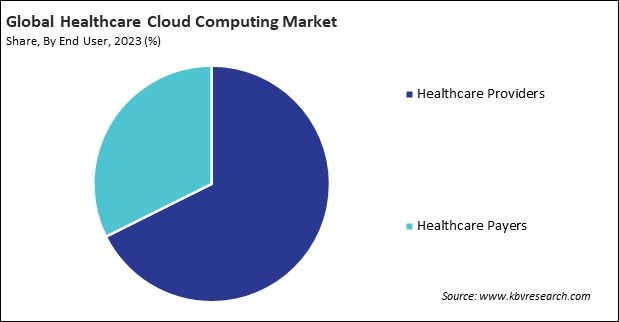
On the basis of service model, the market is classified into software as a service (SaaS), platform as a service (PaaS), and infrastructure as a service (IaaS). The software as a service (SaaS) segment acquired 50% revenue share in the market in 2023. Cloud-based software applications, including electronic health records (EHRs), telehealth platforms, and patient management systems, have been widely adopted, which may be the reason for this. SaaS solutions offer healthcare organizations the flexibility to access applications through the cloud without complex on-premise infrastructure, reducing costs and improving efficiency.
Based on deployment model, the market is divided into public cloud, private cloud, and hybrid cloud. The hybrid cloud segment procured 21% revenue share in the market in 2023. By using hybrid cloud solutions, which include the benefits of both public and private clouds, healthcare organizations are able to protect sensitive data in a private cloud environment that is secure while also enjoying the scalability and cost-effectiveness of the public cloud for applications that are less vital.
Free Valuable Insights: Global Healthcare Cloud Computing Market size to reach USD 142.7 Billion by 2031
Region-wise, the market is analyzed across North America, Europe, Asia Pacific, and LAMEA. The North America segment procured 39% revenue share in the market in 2023. The region's leadership in cloud adoption can be attributed to the robust healthcare infrastructure, widespread use of electronic health records (EHRs), and significant investments in digital healthcare technologies. The United States, in particular, has been at the forefront of this growth, with government initiatives such as the Health Information Technology for Economic and Clinical Health (HITECH) Act and the widespread adoption of cloud-based solutions among healthcare providers.
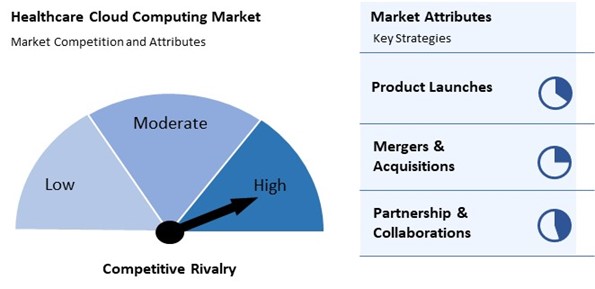
The healthcare cloud computing market is highly competitive, driven by the growing use of digital health solutions, electronic health records (EHRs), and telemedicine. Major players like AWS, Microsoft Azure, IBM Cloud, Google Cloud, and Oracle Cloud dominate due to their robust infrastructures. Companies compete by offering innovative services such as AI, data analytics, and ensuring compliance with healthcare regulations like HIPAA, crucial for securing sensitive patient data.
| Report Attribute | Details |
|---|---|
| Market size value in 2023 | USD 42.5 Billion |
| Market size forecast in 2031 | USD 142.7 Billion |
| Base Year | 2023 |
| Historical Period | 2020 to 2022 |
| Forecast Period | 2024 to 2031 |
| Revenue Growth Rate | CAGR of 17.0% from 2024 to 2031 |
| Number of Pages | 499 |
| Tables | 793 |
| Report coverage | Market Trends, Revenue Estimation and Forecast, Segmentation Analysis, Regional and Country Breakdown, Competitive Landscape, Market Share Analysis, Porter’s 5 Forces Analysis, Company Profiling, Companies Strategic Developments, SWOT Analysis, Winning Imperatives |
| Segments covered | Deployment Model, Application, Service Model, End User, Region |
| Country scope |
|
| Companies Included | Dell Technologies, Inc., Hewlett Packard Enterprise Company, Microsoft Corporation, Oracle Corporation, IBM Corporation, Salesforce, Inc., Amazon Web Services, Inc. (Amazon.com, Inc.), Siemens Healthineers AG (Siemens AG), Koninklijke Philips N.V., NTT Data Corporation |
By Application
By Service Model
By Deployment Model
By End User
By Geography
This Market size is expected to reach $142.7 billion by 2031.
Increasing Adoption of Telehealth Services are driving the Market in coming years, however, Data Privacy and Security Concerns restraints the growth of the Market.
Dell Technologies, Inc., Hewlett Packard Enterprise Company, Microsoft Corporation, Oracle Corporation, IBM Corporation, Salesforce, Inc., Amazon Web Services, Inc. (Amazon.com, Inc.), Siemens Healthineers AG (Siemens AG), Koninklijke Philips N.V., NTT Data Corporation
The expected CAGR of this Market is 17.0% from 2024 to 2031.
The Public Cloud segment is leading the dominated the Market by Deployment Model in 2023; thereby, achieving a market value of $70.2 billion by 2031.
The North America region dominated the Market by Region in 2023; thereby, achieving a market value of $53.4 billion by 2031.
Our team of dedicated experts can provide you with attractive expansion opportunities for your business.
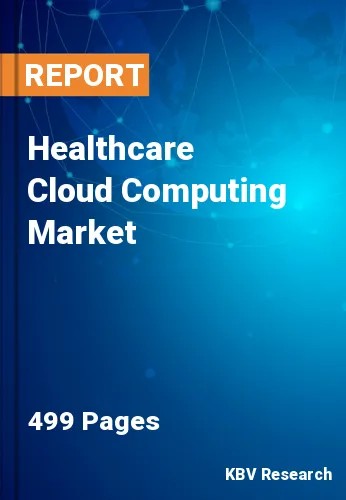
 Drivers
Drivers
 Restraints
Restraints
 Opportunities
Opportunities
 Challenges
Challenges
